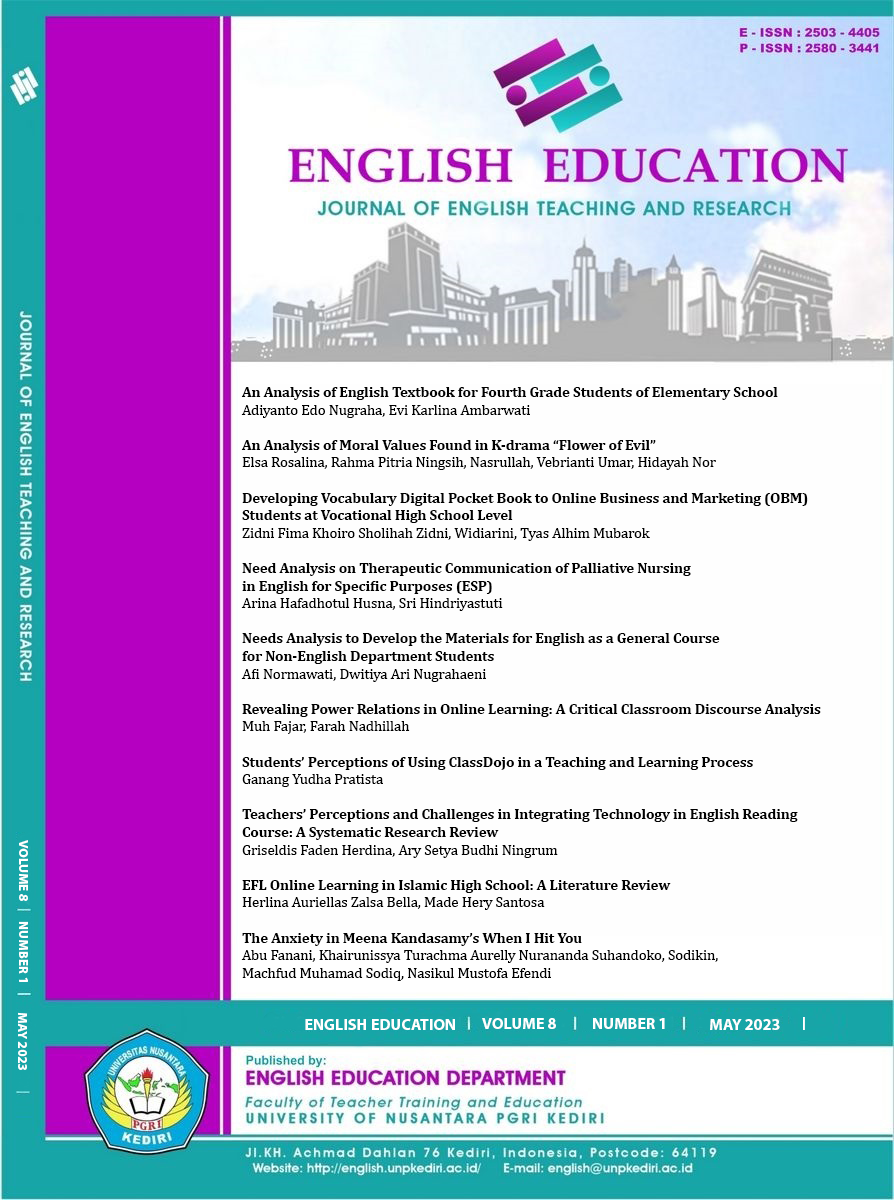An Analysis of Moral Values Found in K-drama “Flower of Evil”
DOI:
https://doi.org/10.29407/jetar.v8i1.18955Keywords:
Analysis; Flower of Evil; K-Drama; Moral Values, Analysis, flower of evil, K-drama, Moral valueAbstract
A literary work is a representation of human thought that has been poured into a medium. The literary works classified as informative literature or imaginative literature. Informative literature focuses on facts, history, explanations, and famous people, whereas imaginative literature is based on fantasy and employs connotative language and qualified aesthetic art. Moral values are the values than can give the readers or viewers some positives message from literary works. This article tries to analyze the K-Drama entitled Flower of Evil. Flower of Evil is one of the most popular K-drama that aired in TVN (One of television station in South Korea) on Wednesday and Thursday from July to September 2020. This drama has got 57th Baeksang arts award for the best director in 2020. Baeksang arts award is one of the precious award in South Korea especially in entertainment industrial. This research uses qualitative method because the researchers try to describe the moral values from the K-Drama Flower of Evil. Documentation method is used for collecting the data of this research. The data analysis method is an important step in this research because it examines the validity and reliability of the data collections. The results of this research are the researchers have found out sixth moral values in this K-Drama. First, don’t judge the people just based on their appearance. Second, making your own reputation as a “good person” is important in today’s society. Third, father is the first love for his daughter. Fourth, family is always together, no matter how far you go family is still the most comfortable place to come home from all of the problems. Fifth, your family is the one who know you better than the other people. Last, the truth will always win.
Keywords: Analysis; Flower of Evil; K-Drama; Moral Values
Downloads
References
Alawiyyah, A., & Oktavi, S. H. (2019). the Analysis of Moral Values in Dangerous Minds Movie By John N. Smith. Dialectical Literature and Educational Journal, 4(1), 18–26. https://doi.org/10.51714/dlejpancasakti.v4i1.6.pp.18-26
Arikunto, S. (2010). Prosedur Penelitian Suatu Pendekatan Praktik. Jakarta: Rineka Cipta.
Endraswara, S. (2008). Metode penelitian psikologi sastra: Teori, langkah dan penerapannya. Bekasi: Media Pressindo.
Fitria, T. N. (2020). An Analysis of Moral Values Found in a Korean TV Series ’ The World of Married’. 2008, 52–64.
Goodman, L. (2001). Literature and Gender. London: The Open University.
Moleong, L, (2002). Metode Penelitian Kualitatif. Bandung : CV. Remaja, hal 11
Nasir, C. (2019). an Analysis of Moral Values in the Movie “Coco.” English Education International Conference (EEIC), 2002, 22–31.
Stevenson, A. (2010). Oxford Dictionary of English. New York: OUP Oxford.
Subrata, I. W. R. F., Piscayanti, K. S., & Suprianti. (2018). an Analysis of Moral Values Found in Robert. X.
Utami, D. B., & Arini, R. (2017). An Analysis Of Moral Values In Burnett’s Little Lord Fauntleroy Novel. JELE (Journal of English Language and Education), 3(1), 29. https://doi.org/10.26486/jele.v3i1.265
https://subslikescript.com/series/The_Flower_of_Evil-11691684/season-1/episode-1-Episode_11
Downloads
Published
Issue
Section
License
Authors who publish with this journal agree to the following terms:
- Copyright on any article is retained by the author(s).
- The author grants the journal, the right of first publication with the work simultaneously licensed under a Creative Commons Attribution License that allows others to share the work with an acknowledgment of the work’s authorship and initial publication in this journal.
- Authors are able to enter into separate, additional contractual arrangements for the non-exclusive distribution of the journal’s published version of the work (e.g., post it to an institutional repository or publish it in a book), with an acknowledgment of its initial publication in this journal.
- Authors are permitted and encouraged to post their work online (e.g., in institutional repositories or on their website) prior to and during the submission process, as it can lead to productive exchanges, as well as earlier and greater citation of published work.
- The article and any associated published material is distributed under the Creative Commons Attribution-ShareAlike 4.0 International License








 Article template
Article template



